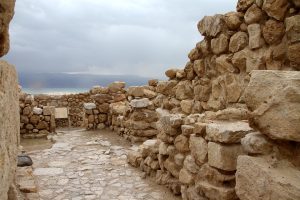What Was Qumran? Not a Country Villa, Jodi Magness, Biblical Archaeology Review (22:06), Nov/Dec 1996.

Building at Qumran. By Gerd Eichmann – Own work, CC BY-SA 4.0, https://commons.wikimedia.org/w/index.php?curid=95571621
Roland de Vaux, who excavated the Judean Desert site in the 1950s, concluded that Qumran had been home to an isolated religious community, whom he identified as Essenes. However, Belgian archaeologists Robert Donceel and Pauline Donceel-Voûte, who were asked to prepare some of the material from de Vaux’s excavation for final publication, have presented an entirely different interpretation of the site. Citing the “unexpected variety and richness of the objects” uncovered by de Vaux, the Donceels contend that the settlement at Qumran functioned as a villa rustica, that is, a Roman-type villa complete with the dwellings, workshops, stables and other buildings associated with a productive rural estate.2 As a villa rustica, Qumran would have provided some wealthy family with a warm refuge from Jerusalem’s bitter winter chill.
Read the rest of What Was Qumran? Not a Country Villa in the online Biblical Archaeology Society Library.
What do you want to know?
Ask our AI widget and get answers from this website